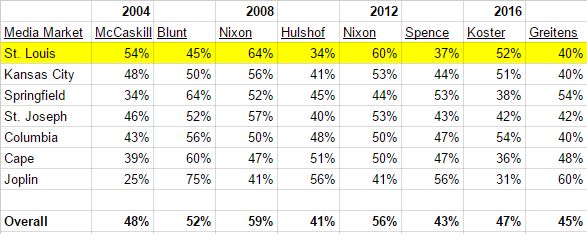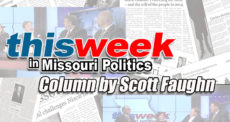JEFFERSON CITY, Mo. – The Missouri Governor’s race is officially neck-and-neck in Missouri, and the breakdown of support for each candidate based on the region’s media markets shows favorability in the larger markets swinging in favor of the Democratic candidate, while the smaller, rural regions show heavy support for Republicans.
Here’s a breakdown of how the gubernatorial candidates have and are faring in each media market:
ST. LOUIS MEDIA MARKET– Average of 1,136,000 voters
Koster boasts a hefty 16-point lead over Greitens here, according to the latest Missouri Times polling. Compared to previous gubernatorial races, he’ll need stronger showings to win. Nixon won this market handily in 2008 and 2012, with 30 percent and 23 percent respectively. McCaskill only secured a nine-point lead in 2004, pulling in 54 percent, one less than Koster is holding right now. It all boils down to how St. Louis and St. Louis County vote, as they account for around 60 percent of the votes in this market.
KANSAS CITY MEDIA MARKET – Average of 528,000 voters
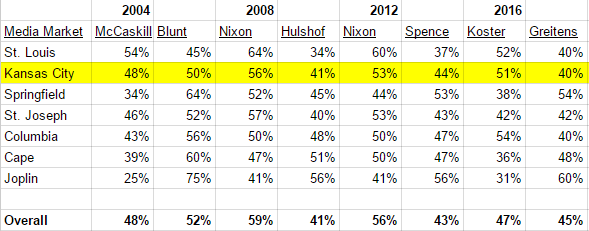
Another large predominantly Democrat base in Missouri, Koster once again leads by roughly 12 points. 52-40. Nixon carried this market as well in 2008 and 2012, with 15 and 11 points, respectively. Blunt managed to win by a narrow two percent margin here in 2004, but if the previous three gubernatorial races are any indicators, then the smaller counties will tend to lean for the conservative candidate. While the market boasts 25 counties in its region, whoever carries Jackson County – the largest county – typically wins the Kansas City media market.
SPRINGFIELD MEDIA MARKET – Average of 405,000 voters
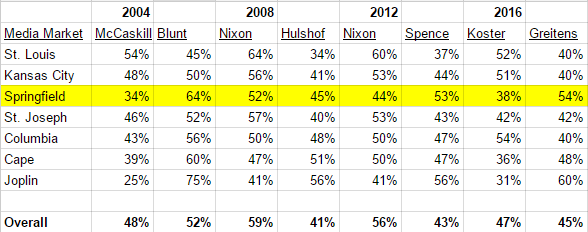
Here’s where things start to shake up. The Springfield market typically leans conservative for their candidates. It seems like that will be the case in 2016, as Eric Greitens has a strong showing in the area. He’s currently looking at anywhere from a 15 point lead up to 27 points. While carrying the Springfield market can significantly boost their numbers, Dave Spence’s campaign showed that doesn’t necessarily mean a win. He won the region with a 53 percent of the vote, but still lost to the incumbent Jay Nixon, 56-43.
ST. JOSEPH MEDIA MARKET- Average of 50,000 voters
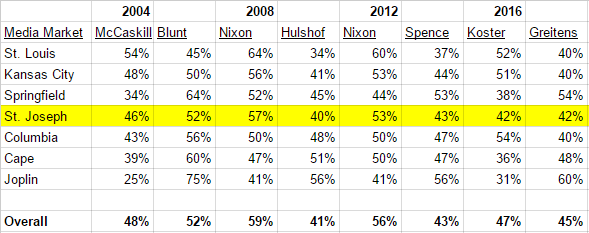
Winning this market simply means one thing: winning Buchanan County. Buchanan County accounts for roughly 70 percent of the votes in this market, because there are only three counties in the market. Right now, it looks like Greitens will pull out the win.
COLUMBIA MEDIA MARKET – Average of 215,000 voters
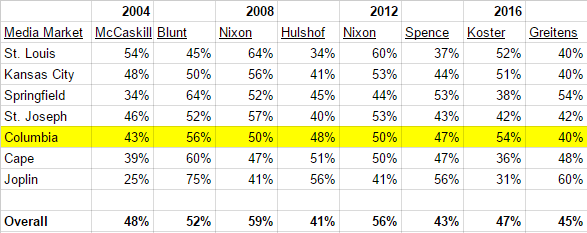
In 2008 and 2012, the Columbia/Jefferson City market kept it close, with Nixon winning by two or three points in each race, respectively. Boone County is the largest county, and leans left, but the other counties in the market are more than enough to swing the favor in the opposite direction. In 2004, Boone County was the only county in this market that McCaskill won. The rest of the counties threw their support behind Blunt, who won the region by 13 percent.
CAPE GIRARDEAU MEDIA MARKET – Average of 144,000 voters
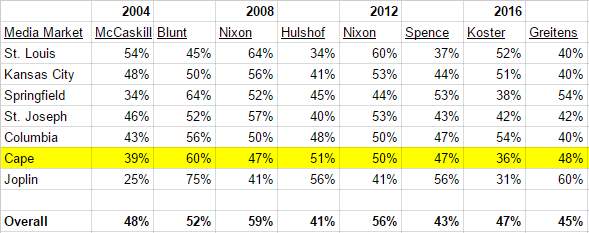
The Cape typically votes red. Blunt carried this area 60-39 in 2004, Hulshof won a close race 51-47 in 2008, but in 2012, Nixon pulled out a close 50-47 win, breaking the trend. The difference here is that in 2012, only 133,614 votes were cast. In the previous two races, that number was just under 150,000.
That being said, the polls show the trend may return in 2016, with Greitens showing some of his best numbers in this market.
JOPLIN MEDIA MARKET – Average of 90,000 voters
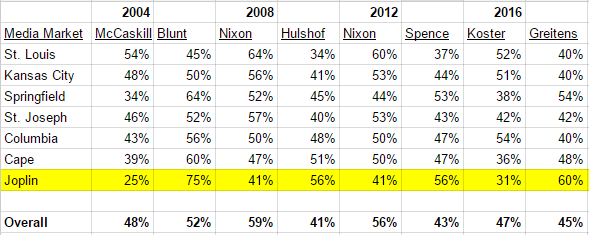
Barring a major upset, Greitens will win this market. Remember, the trends show that the smaller regions tend to support Republicans, and this region has not given a Democratic gubernatorial candidate more than 41 percent of their votes in over a decade. With our polling showing Koster with 22 percent of the vote, this trend will continue.
Benjamin Peters was a reporter for The Missouri Times and Missouri Times Magazine and also produced the #MoLeg Podcast. He joined The Missouri Times in 2016 after working as a sports editor and TV news producer in mid-Missouri. Benjamin is a graduate of Missouri State University in Springfield.


